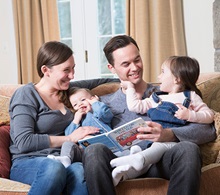 Premier Academy knows weight and body image are extremely sensitive topics to discuss with your children. It is our goal as parents and as daycare teachers to teach healthy eating practices while also contributing to making sure our children have a positive body image. This can sometimes be tricky. We know we need to start young and set the stage for healthy lifetime habits early.
Premier Academy knows weight and body image are extremely sensitive topics to discuss with your children. It is our goal as parents and as daycare teachers to teach healthy eating practices while also contributing to making sure our children have a positive body image. This can sometimes be tricky. We know we need to start young and set the stage for healthy lifetime habits early.
Children Model Eating Habits After Us
If parents and childcare providers have healthy eating habits, children are more likely to follow along. On the flip side, if children see adults eating unhealthy food, they are more likely to emulate that behavior. You can be good role models for a healthy lifestyle by building family nutrition and fitness into your family’s day and your quality childcare provider’s day on a regular basis. Can we share meals together – lunch or dinner – at least four days per week? Are there ways we can exercise together, for example, swimming, walking or bike rides to promote healthy exercise habits?
Be careful about the messages you may be sending to children about food and eating when you discuss/model healthy eating habits. One thing you may not know; it’s not the best practice for you to require children to eat everything on their plate at mealtime. There are different opinions on this, but some health educators encourage children to try one bite of everything, never pushing or forcing. Others advocate for offering children a favorite food and a new food together so they will have at least one healthy food option that they like.
Try to avoid labeling different foods as “bad” or “unhealthy”. This can be confusing to children when they then see a beloved caregiver or friend eating that food. You can say that healthy eating refers to the whole of what we eat, and not one specific food or foods which are “bad” for you. Premier Academy strives to be the best childcare by taking the approach of encouraging healthier snacks instead of singling out “bad” foods.
KidsHealth.org offers “Go, Slow, and Whoa!” as another approach to healthy eating:
- “Go” foods are the healthiest options for kids and can be eaten almost anytime
- “Slow” foods are those you can eat sometimes but not every day
- “Whoa” foods should make you think, “Wait, should my child eat that?” These are the least nutritious and should only be eaten occasionally.
Healthy Habits for Youngsters
- Infants: With infants, we pay attention to their cues, and stop feeding them when they indicate they are finished by turning away or refusing the breast, bottle or spoon. Be careful what food choices you make for your baby. It is recommended to wait until a child is four months old or later to start introducing solid foods. And if the child’s first sold foods are desserts or fruits, they can develop a preference for sweets over other foods.
- Toddlers and Preschoolers: With toddler and preschool children, provide healthy snacks and beverages such as water. Eating slowly together as a family is a good practice. Never require children to eat when they are not hungry. Also, avoid using food or lack of food as a reward or punishment. If you notice that your child is developing eating issues, they should be discussed with your pediatrician right away.
Talking to Older Children about Healthy Habits and Positive Body Image
Children are constantly immersed in images and talk of the “ideal” body. And yet we all know genetics gives each of us a unique body type, few of which fall into the “ideal” category.
With tweens and teens, subtle and not so subtle messages about weight and body type have an impact. These body images come from people, television, magazines, social media, etc. If your son or daughter opens up the subject, use it as an opportunity to communicate that very few people look like models; models also feel stress about their bodies; and being really skinny isn’t always a good thing.
If your child says “I’m too fat” rather than jumping to “No, you’re not” right away, ask “What makes you think that?” to try to keep the conversation open and keep your child talking about this issue. It’s important to know how to communicate with your child. Spend time listening to him or her. Express your feelings about the topic, but rather than negating your child’s feelings, try saying, “Here’s what I think. . . ” so it feels more like your personal thoughts than a judgment on your child. At the same time, if you ever suspect an eating disorder, talk right away to your pediatrician to find resources.
Talking about weight, body image and health can be sensitive, but it is also very worthwhile to keep the topic on the table and encourage children to talk about what they think and feel. Remember that feelings about this body image start early so be thoughtful about the impact of your words and actions in your child’s life.
Enroll Today! Click Here
 An article from PBS Parents, Helping Your Child Make New Friends, offers some advice on how to help a shy child who struggles with making friends come out of his or her shell. Here are some of the tips contained in the article:
An article from PBS Parents, Helping Your Child Make New Friends, offers some advice on how to help a shy child who struggles with making friends come out of his or her shell. Here are some of the tips contained in the article:
:max_bytes(150000):strip_icc():format(webp)/GettyImages-538460233web-56f0373e5f9b5867a1c583cd.jpg)
